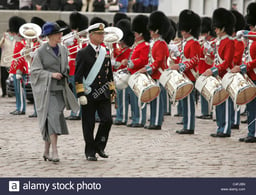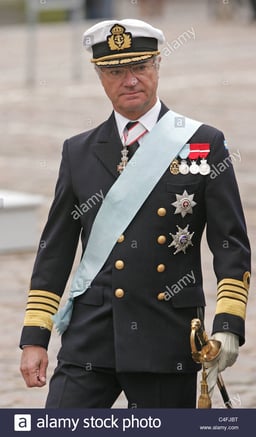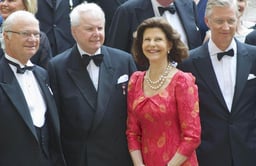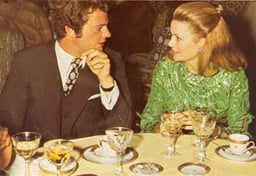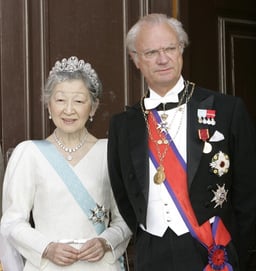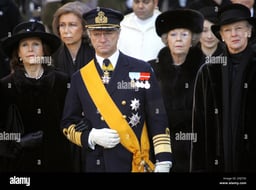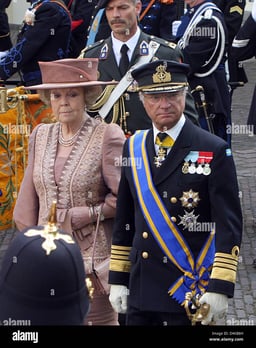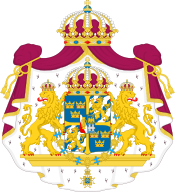Carl XVI Gustaf of Sweden
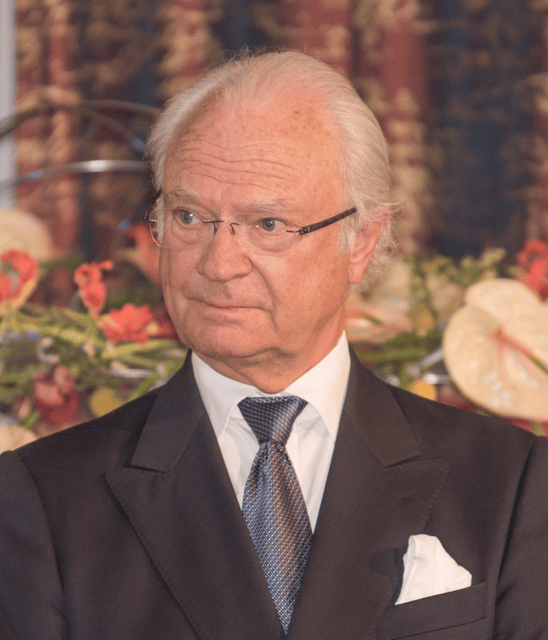
Carl XVI Gustaf of Sweden

| Carl XVI Gustaf | |||||
|---|---|---|---|---|---|
| King of Sweden | |||||
| Reign | 15 September 1973 – present | ||||
| Enthronement | 19 September 1973 | ||||
| Predecessor | Gustaf VI Adolf | ||||
| Heir apparent | Victoria | ||||
| Prime Ministers | See list
| ||||
| Born | (1946-04-30)30 April 1946 Haga Palace, Solna, Sweden | ||||
| Spouse | Silvia Sommerlath (m.1976) | ||||
| Issue Detail |
| ||||
| |||||
| House | Bernadotte | ||||
| Father | Prince Gustaf Adolf, Duke of Västerbotten | ||||
| Mother | Princess Sibylla of Saxe-Coburg and Gotha | ||||
| Religion | Church of Sweden | ||||
| Signature | |||||
| Full name | |||||
| Carl Gustaf Folke Hubertus | |||||
Carl XVI Gustaf (Carl Gustaf Folke Hubertus; born 30 April 1946) is the King of Sweden. He ascended the throne on the death of his grandfather, King Gustaf VI Adolf, on 15 September 1973.
He is the youngest child and only son of Prince Gustaf Adolf, Duke of Västerbotten, and Princess Sibylla of Saxe-Coburg and Gotha. His father died on 26 January 1947 in an airplane crash in Denmark when Carl Gustaf was nine months old. Upon his father's death, he became second in line to the throne, after his grandfather, the then Crown Prince Gustaf Adolf. Following the death of his great-grandfather King Gustaf V in 1950, Gustaf Adolf ascended the throne and thus Carl Gustaf became Sweden's new crown prince and heir apparent to the throne at the age of four.
A short while after he became king in 1973, the new 1974 Instrument of Government took effect, formally stripping Carl XVI Gustaf of any role in the legislative process, and several other duties normally accorded to a head of state, such as the formal appointment of the prime minister, signing off legislation, and being commander-in-chief of the nation's military. The new instrument explicitly limits the king to ceremonial functions and, among other things, to be regularly informed of affairs of state. As head of the House of Bernadotte Carl Gustaf has also been able to make a number of government-supported decisions about the titles and positions of its members.
The king's heir apparent, after passage on 1 January 1980 of a new law establishing absolute primogeniture (the first such law passed in European history[1]), is Crown Princess Victoria, the eldest child of the King and his wife, Queen Silvia. Before the passage of that law, Crown Princess Victoria's younger brother, Prince Carl Philip, was briefly the heir apparent, as of his birth in May 1979.
Carl XVI Gustaf is the longest-reigning monarch in Swedish history, having surpassed King Magnus IV's reign of 44 years and 222 days on 26 April 2018.[2]
| Carl XVI Gustaf | |||||
|---|---|---|---|---|---|
| King of Sweden | |||||
| Reign | 15 September 1973 – present | ||||
| Enthronement | 19 September 1973 | ||||
| Predecessor | Gustaf VI Adolf | ||||
| Heir apparent | Victoria | ||||
| Prime Ministers | See list
| ||||
| Born | (1946-04-30)30 April 1946 Haga Palace, Solna, Sweden | ||||
| Spouse | Silvia Sommerlath (m.1976) | ||||
| Issue Detail |
| ||||
| |||||
| House | Bernadotte | ||||
| Father | Prince Gustaf Adolf, Duke of Västerbotten | ||||
| Mother | Princess Sibylla of Saxe-Coburg and Gotha | ||||
| Religion | Church of Sweden | ||||
| Signature | |||||
| Full name | |||||
| Carl Gustaf Folke Hubertus | |||||
Early life
Carl Gustaf was born on 30 April 1946 at 10:20[3] in Haga Palace in Solna, Stockholm County. He was the youngest of five children and the only son of Sweden's Prince Gustaf Adolf and Princess Sibylla. He was christened at the Royal Chapel on 7 June 1946 by the Archbishop of Uppsala, Erling Eidem.
He was baptised in Charles XI's baptismal font, which stood on Gustav III's carpet and he lay in Charles XI's cradle with Oscar II's crown beside him.[4] The same christening gown in white linen batiste which the prince carried had been worn by his father in 1906 and would later be worn by his three children.[5] His godparents were the Crown Prince and Crown Princess of Denmark (his paternal uncle and aunt), the Crown Prince of Norway, Princess Juliana of the Netherlands, the King of Sweden (his paternal great-grandfather), the Hereditary Prince of Saxe-Coburg and Gotha (his maternal uncle), the Crown Prince and Crown Princess of Sweden (his paternal grandfather and step-grandmother), and Count Folke and Countess Maria Bernadotte af Wisborg.[6]
Prince Carl Gustaf was also given the title of the Duke of Jämtland. His father, Prince Gustaf Adolf, Duke of Västerbotten was killed in an airplane crash on 26 January 1947, at Copenhagen Airport. His father's death had left the nine-month-old prince second in line for the throne, behind his grandfather, then Crown Prince Gustaf Adolf. When his paternal great-grandfather Gustaf V died in 1950, the four-year-old prince became the heir apparent of Sweden.
Carl Gustaf was seven years old before he was told about his father's death, and he expressed his feelings about growing up without knowing his father in a speech in 2005.
Youth and education
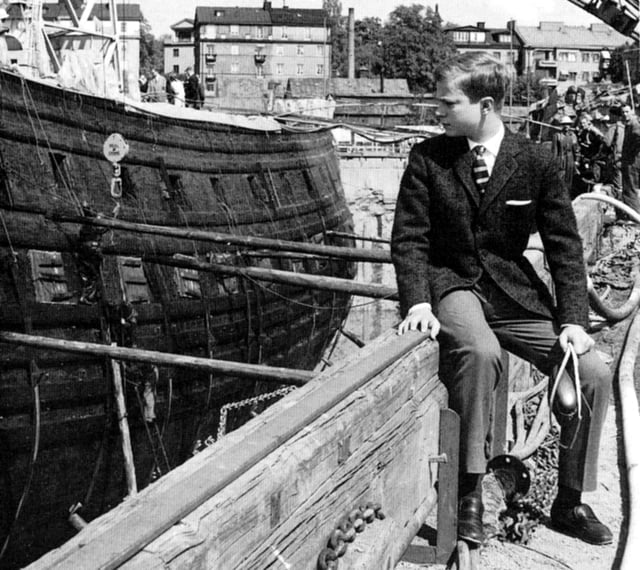
The 15-year-old Crown Prince of Sweden looks at the recently recovered 17th-century warship Vasa in 1961.
His earliest education was received privately at the Royal Palace. The young prince was then sent to Broms school, and then on to Sigtuna boarding school. After graduating from high school in 1966, Carl Gustaf completed two-and-a-half years of education in the Swedish Army, the Royal Swedish Navy, and the Swedish Air Force. During the winter 1966-1967 he took part in a round-the-world voyage with the mine-laying vessel Älvsnabben. The Crown Prince received his commission as an officer in all three services in 1968, eventually rising to the rank of captain (in the army and air force) and lieutenant (in the navy), before his ascension to the throne. He also completed his academic studies in history, sociology, political science, tax law, and economics at Uppsala University and later Economics at Stockholm University.[7]
To prepare for his role as the head of state, Crown Prince Carl Gustaf followed a broad program of studies on the court system, social organisations and institutions, trade unions, and employers' associations. In addition, he closely studied the affairs of the Riksdag, Government, and Ministry for Foreign Affairs. The Crown Prince also spent time at the Swedish Mission to the United Nations and the Swedish International Development Cooperation Agency (SIDA), worked at a bank in London and at the Swedish Embassy there, at the Swedish Chamber of Commerce in France, and at the Alfa Laval Company factory in France. In 1970 he represented the King at the head of the Swedish delegation to the World Exposition in Osaka, Japan. Since his youth the present monarch has been a strong supporter of the Scout Movement in Sweden.[8]
Reign
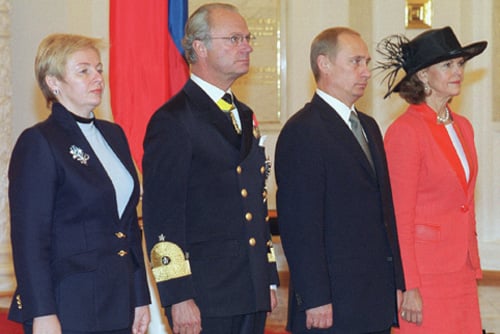
The King and Queen of Sweden welcomed at the Kremlin by Russian President Vladimir Putin and his wife Lyudmila at the start of the King's state visit to Russia, 8 October 2001.
On 15 September 1973, Carl Gustaf became King of Sweden upon the death of his grandfather, Gustaf VI Adolf. On September 19, he took the required regal assurance (Swedish: Konungaförsäkran) during an extraordinary meeting of the cabinet. Afterwards, he appeared before the parliament, diplomatic corps, court, etc. in the Hall of State at the Royal Palace where he gave a speech. Both the cabinet meeting and ceremony at the Hall were broadcast live on television. Following the ceremonies, he appeared on the balcony to acknowledge gathered crowds. At the cabinet meeting, the King declared that his name would be Carl XVI Gustaf and that his title would be King of Sweden. He adopted, "For Sweden – With the times" as his personal motto[11] (För Sverige – i tiden).[12][13]
The Regal Assurance taken by His Majesty King Carl XVI Gustaf on 19 September 1973, administered by Mr. Lennart Geijer, Councillor of State and Minister of Justice:
"We, Carl Gustaf, King of Sweden, make it known: that since it has pleased the Highest God call to Him on High the former Mighty-powerful, Highborn Prince and Lord, Gustaf VI Adolf, King of the Swedes, the Goths and the Wends, and We, according to and by the power of the Act of Succession established and ascertained by the Estates of the Realm on 26 September 1810, succeeding the aforementioned Exalted Lord have ascended to the Royal Swedish Throne. In so doing We hereby affirm, and that with the greatest emphasis, that We desire to, and shall, govern the Realm according to the literal requirement of the Form of Government, for their compliance ascertained and adopted jointly on 6 June 1809 by the King and the Estates of the Realm, as well as by any other legitimate constitutional law of the Realm, public law and legal ordinance. We shall also, according to the aforementioned Form of Government and laws, seek by Our utmost capability, as a righteous King and gracious father to the Swedish people, and by a legal, fair and mild rule, and so that We might defend that rule with a clear conscience before God on High, further the veritable progress and good of the realm and every resident, all of which being what We of free will and mature deliberation have decided, We thus confirm by the signing of Our name in Our own hand and with this vibrant oath, that We such shall obey and execute.
So truly help me God by my life and soul."
When Carl Gustaf ascended the throne, plans were already in place to replace the 1809 Instrument of Government, which made the King de jure chief executive. Though the King was a near-autocrat on paper, the Riksdag's authority grew steadily into the early 20th century. In 1914, Gustaf V made a speech which resulted in what is known as the Courtyard Crisis (Swedish: Borggårdskrisen) wherein he was accused of interfering with politics. With the principle of parliamentary democracy formally established since 1917, the King's actual direct involvement in policy-making lessened and the powers constitutionally vested in him were increasingly done by ministers in his name, notwithstanding the Instrument's stipulation that "the King alone shall govern the realm."
The new 1974 Instrument of Government first took effect on 1 January 1975 and formally stripped the new king of most of his formal political powers and reduced him to a mostly representative and ceremonial role, thus codifying actual practices dating from the definitive establishment of parliamentary government in 1917. Previously, the King formally appointed the Prime Minister, though in practice he was almost always the leader of the majority party or coalition in the Riksdag. Since the adoption of the current Instrument, a prospective prime minister is nominated by the Speaker of the Riksdag, and if that candidate is elected by the Riksdag, the Speaker signs the commission (Swedish: förordnande). Additionally, bills passed by the Riksdag do not need Royal assent to become law.
He is the foremost representative of Sweden and pays state visits abroad and receives those to Sweden, he opens the annual session of the Riksdag, chairs the Special Council held during a change of Government (Swedish: skifteskonselj), holds regular Information Councils with the Prime Minister and the Cabinet (Swedish: informationskonselj), chairs the meetings of the Foreign Affairs Council (Swedish: Utrikesnämnden), and receives Letters of Credence of foreign ambassadors to Sweden and signs those of Sweden to foreign nations. As this type of figurehead, he also voluntarily abstains from voting in Swedish elections.[14]
King Carl Gustaf holds the highest ranks in the three branches of the Swedish Armed Forces; this is due to the fact that he was, as stipulated by §14 of the 1809 Instrument of Government in effect at the time of his accession to the throne in 1973, the Commander-in-Chief (Swedish: Högste Befälhavare; not to be confused with the military professional holding the position of Supreme Commander) and therefore he was promoted ex officio from his earlier ranks of captain (Army & Air Force) and lieutenant (Navy), to general and admiral. Under the provisions of the Instrument of Government of 1974, which became effective on 1 January 1975, the King no longer holds this constitutionally-mandated position, but he kept his ranks à la suite since he no longer has any military command authority, except over His Majesty's Military Staff.
Worldwide, Carl XVI Gustaf is probably best known as the presenter of the Nobel Prizes each year; the first Nobel laureate who received the prize from his hands was Leo Esaki.[15] He also hands over the Polar Music Prize. The King holds honorary doctoral degrees from the Swedish University of Agricultural Sciences, the Royal Institute of Technology, the Stockholm School of Economics and from the Åbo Akademi University in Finland.
Personal interests

Royal monogram
The King is passionate about the environment, technology, agriculture, trade, and industry. Like many members of the Swedish royal family, he has a keen interest in automobiles. He owns several Porsche 911s, a car model which is said to be a particular favourite of his, as well as a vintage Volvo PV444, a Ferrari 456M GT, an AC Cobra and other cars.[16] The first pictures taken of him and his future wife were of them sitting in his Porsche 911. In the summer of 2005 he was involved in a traffic accident in Norrköping. The accident was described as a "fender bender", with no serious personal injuries claimed. Nevertheless, the incident caused national headlines.[17] The King and Queen of Sweden frequently travel to the Summer and Winter Olympic Games, including in 2014, 2016 and 2018.[18][19]
Scouting
The King is the honorary chairman of the World Scout Foundation, and often participates in Scout activities both in Sweden and abroad. He regularly visits World Scout Jamborees, for instance the 1979 Dalajamb World Jamboree International Encampment hosted by Sweden, the 2002 World Jamboree held in Sattahip, Thailand, and the 100th Anniversary of World Scouting 2007 World Jamboree held in Hylands Park, England.[20] He also attended the 1981 National Scout Jamboree in Virginia, United States, and was awarded the Bronze Wolf, the only distinction of the World Organization of the Scout Movement, awarded by the World Scout Committee for exceptional services to world Scouting, in 1982. He also attended the 22nd World Scout Jamboree. He gave a speech on 6 August 2011 at the closing ceremony with more than 40,000 people watching. The band Europe also performed for him singing "The Final Countdown". King Carl Gustaf made an appearance at the 2013 Boy Scouts of America National Jamboree in West Virginia.[21] Together with King Abdullah of Saudi Arabia, King Carl Gustaf has supported the Messengers of Peace programme.
Use of remaining power
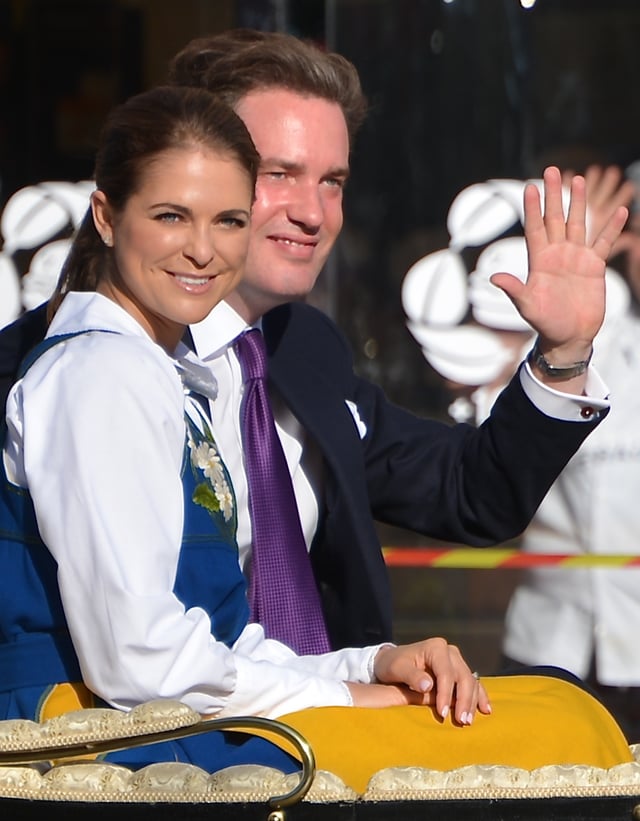
A new Swedish double duchy was created for Princess Madeleine (left) in 1982, whereas her husband in 2013 declined to become a Swedish citizen, prince and duke and is called Herr Christopher O'Neill in Sweden
So empowered as head of the House of Bernadotte,[22] King Carl Gustaf since he was enthroned in 1973 has made a number of personal decisions regarding the titles and positions of relatives and family members, including the demotion of a sister, elevation of several commoners to royalty, rebuff of an elderly uncle's wishes and the creation of new Swedish titles and duchies.
1974: his sister Christina married a non-royal Swedish man and Carl Gustaf followed the example which his grandfather and predecessor had set for two of Christina's older sisters with like marriages, so Christina was removed from the Royal House, no longer a Royal Highness and was given the courtesy title Princess Christina, Mrs. Magnuson (a special non-royal, non-noble style first invented in 1953 by King Haakon VII of Norway for his granddaughter Ragnhild).
1976: his own choice, taking advantage of his constitutional prerogative as King when he married a non-royal German-Brazilian woman, saw her created Her Majesty Queen Silvia of Sweden.
1976: his paternal uncle Bertil (later that year) married the non-royal British woman who had lived with Bertil for decades, and (with Bertil's titles) Carl Gustaf created her a Royal Highness Princess of Sweden and Duchess of Halland.
1977: his daughter Victoria was born, and in 1980 Carl Gustaf created her Duchess of Västergötland (which has had duchesses before).
1979: his son Carl Philip was born, and Carl Gustaf created him Duke of Värmland (which has had dukes before).
1982: his daughter Madeleine was born, and Carl Gustaf created a new duchy for her as Duchess of Hälsingland and Gästrikland.
1983: his paternal uncle Sigvard, since 1934 no longer Prince of Sweden because of a non-royal marriage to a German woman, supported by legal experts[23] announced his own title as Prince Sigvard Bernadotte, 18 years later clearly citing a great-uncle Prince Oscar Bernadotte's title as his main precedent;[24] however, Sigvard died in 2002 with Carl Gustaf never having responded to his uncle's statement, and with the Royal Court of Sweden consistently refusing to honor it.
2003: his paternal grandfather's first cousin Carl died, and Carl Gustaf formally recognized his Belgian title by allowing Prince Carl Bernadotte on the gravestone at the Royal Cemetery which is owned by the king; in 2014 he did the same there, allowing Carl's widow's name as Princess Kristine Bernadotte when she died.
2010: his daughter Victoria married a non-royal Swede whom Carl Gustaf created a Royal Highness Prince of Sweden and (with her title) Duke of Västergötland.
2012: his granddaughter Estelle was born and created Duchess of Östergötland (which has had duchesses before).
2013: his daughter Madeleine married a non-royal British American who declined Swedish citizenship, and Carl Gustaf gave him the special courtesy title of Herr (with a capital h).
2014: his granddaughter Leonore was born and created Duchess of Gotland (which also previously has been a duchy).
2015: his son Carl Philip married a non-royal Swede whom Carl Gustaf created a Royal Highness Princess of Sweden and (with the son's title) Duchess of Värmland.
2015: his grandson Nicolas was born, and Carl Gustaf created a new duchy for him as Duke of Ångermanland.
2016: his grandson Oscar was born and created Duke of Scania (which has had dukes before).
2016: his grandson Alexander was born (later that year) and created Duke of Södermanland (which has had dukes before).
2017: his grandson Gabriel was born and created Duke of Dalarna (which has had dukes before).
2018: his granddaughter Adrienne was born, and Carl Gustaf created a new duchy for her as Duchess of Blekinge.
Marriage and family
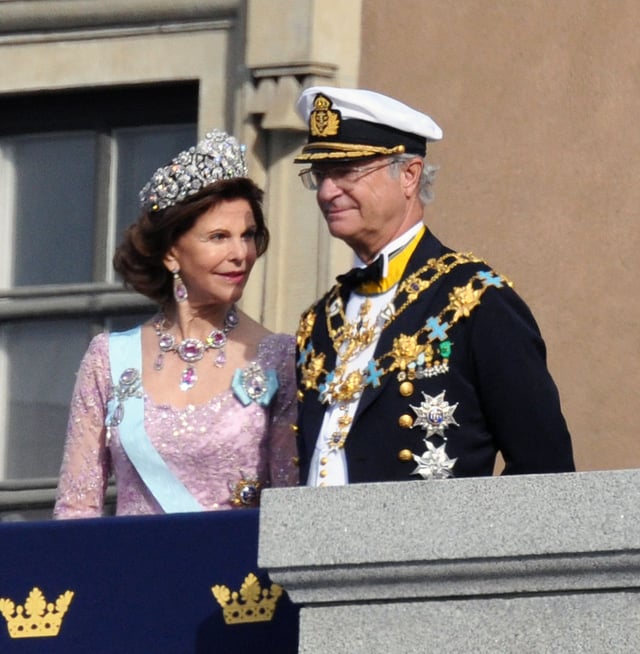
King Carl XVI Gustaf with Queen Silvia at the royal wedding of their daughter Victoria
The King married Silvia Sommerlath, whose father was German and whose mother was Brazilian, and who had grown up in both countries. They met at the 1972 Summer Olympics in Munich, where she was an interpreter and host. The wedding was held on 19 June 1976 at Stockholm Cathedral, the ceremony performed by the Archbishop of Uppsala, Olof Sundby.[25] The wedding was preceded the previous evening by a Royal Variety Performance, at which the Swedish musical group ABBA performed "Dancing Queen" for the very first time, as a tribute to Sweden's future queen.[26][27] The King and his family moved to Drottningholm Palace west of Stockholm in 1980. He and the Queen have maintained their business offices at the Royal Palace of Stockholm.
King Carl Gustaf and Queen Silvia have three children and seven grandchildren:
Crown Princess Victoria, Duchess of Västergötland (born 14 July 1977). On 19 June 2010, she married Daniel Westling, and they are informally styled as the Crown Princess Couple. They have two children: Princess Estelle, Duchess of Östergötland (born 23 February 2012) Prince Oscar, Duke of Skåne (born 2 March 2016)
Prince Carl Philip, Duke of Värmland (born 13 May 1979). On 13 June 2015, he married Sofia Hellqvist, and they are informally styled as the Prince Couple. They have two children: Prince Alexander, Duke of Södermanland (born 19 April 2016) Prince Gabriel, Duke of Dalarna (born 31 August 2017)
Princess Madeleine, Duchess of Hälsingland and Gästrikland (born 10 June 1982). On 8 June 2013, she married Christopher O'Neill, and they are informally styled as the Princess Couple. They have three children: Princess Leonore, Duchess of Gotland (born 20 February 2014) Prince Nicolas, Duke of Ångermanland (born 15 June 2015) Princess Adrienne, Duchess of Blekinge (born 9 March 2018)
Prince Carl Philip was born the heir apparent. However, a constitutional reform, which was already under way at the time of his birth, made his elder sister, Victoria, the heir apparent and Crown Princess of Sweden on 1 January 1980, according to the principles of absolute primogeniture, which Sweden was the first recognised monarchy to adopt.[28] King Carl Gustaf objected after the reform, not to the succession by females but to the fact that his son lost the position and title which he had had since birth.[29]
Titles, styles, honours and arms
Title and styles
30 April 1946 – 7 June 1946: His Royal Highness Prince Carl Gustaf of Sweden
7 June 1946 – 29 October 1950: His Royal Highness Prince Carl Gustaf of Sweden, Duke of Jämtland
29 October 1950 – 15 September 1973: His Royal Highness The Crown Prince of Sweden, Duke of Jämtland
15 September 1973 – present: His Majesty The King of Sweden
King Gustaf VI Adolf was the last who used the style "By the Grace of God King of the Swedes, the Goths/Geats and the Wends" (med Guds Nåde Sveriges, Götes och Wendes Konung; Latin: Dei Gratia Suecorum, Gothorum et Vandalorum Rex). This traditional title had been in use since the establishment of the hereditary monarchy in 1544. Carl XVI Gustaf instead chose the plain and simple title "King of Sweden" (Sveriges Konung), thereby ending a centuries-old tradition.[30]
Regnal name
In the 16th century, Johannes Magnus construed a mythical line of Swedish kings, beginning with Magog, the son of Japheth, in an attempt to substantiate the antiquity of the Swedish throne. Based on that list, King Charles IX (reigned 1604 to 1611) adopted an ordinal unsupported by reliable historical sources. The only two previous monarchs named Charles (Karl in Swedish) have traditionally been numbered by counting backwards from Charles IX, and subsequent monarchs by counting forward from him. Adhering to that tradition, the current King of Sweden proclaimed himself Carl XVI Gustaf even though he is only the tenth Swedish monarch by the first name.[31]
Arms
On his creation as Duke of Jämtland, Carl XVI Gustaf was granted an achievement of arms which featured the arms of Jämtland in base (these arms can be seen on his stallplate as knight of the Danish Order of the Elephant at Frederiksborg Palace). Since his accession to the throne, he has used the greater coat of arms of Sweden although he is still associated with the ducal title of Jämtland.
| Arms of Carl Gustaf as Duke of Jämtland from 1950 to his accession | |
| Arms of Carl XVI Gustaf used since his accession to the throne. |
Honours
National
Foreign
Argentina: Grand Cross with Collar of the Order of the Liberator General San Martín[33][34]
Austria: Grand Star of the Order of Honour for Services to the Republic of Austria, Special Class[33][35][36]
Belgium: Knight Grand Cross of the Order of Leopold I[33][37][38]
Brazil: Grand Collar of the Order of the Southern Cross[33][39][40][41]
Brunei: Knight Grand Cross of the Royal Family Order of the Crown of Brunei[33][42][43][44]
Bulgaria: Grand Cross of the Order of Stara Planina[33][45][46][47]
Chile: Collar of the Order of Merit[33]
Croatia: Grand Cross of the Grand Order of King Tomislav[48]
Denmark: Knight with Collar of the Order of the Elephant[33][49][50][51][52][53] Knight Grand Commander of the Order of the Dannebrog[33][49][54] Recipient of the Silver Anniversary Medal of Queen Margrethe II and Prince Henrik[55]
Estonia: Grand Cross with Collar of the Order of the Cross of Terra Mariana[33][56][57] Grand Cross with Collar of the Order of the White Star[33][58][59][60]
Finland: Grand Cross with Collar of the Order of the White Rose[33][61][62][63]
France: Grand Cross of the Order of the Legion of Honour[33][64][64]
Germany: Grand Cross Special Class of the Order of Merit of the Federal Republic of Germany[33][65][66] Ducal Family of Saxe-Coburg and Gotha: Knight Grand Cross of the Ducal Royal Saxe-Ernestine Saxe-Coburg and Gotha House Order[33][67]
Holy See: Knight with the Collar of the Order of Pope Pius IX[33]
Hungary: Grand Cross with Collar of the Order of Merit of the Republic of Hungary[33]
Iceland: Grand Cross with Collar of the Order of the Falcon[33][69][70][71]
Indonesia: Bintang Republik Indonesia Adipurna of the Order of the Star of the Republic of Indonesia[33][72]
Iranian Imperial Family: Recipient of the Commemorative Medal of the 2,500 year Celebration of the Persian Empire[73][74]
Italy: Grand Cross with Collar of the Order of Merit of the Italian Republic[33][75][76]
Japan: Knight Grand Cordon with Collar of the Order of the Chrysanthemum[33][77][78][79]
Jordan: Knight Grand Cordon with Collar of the Order of al-Hussein bin Ali[33][80][81]
Latvia: Grand Cross with Chain of the Order of the Three Stars[33][82] Grand Cross of the Order of Viesturs[83]
Lithuania: Grand Cross with Golden Chain of the Order of Vytautas the Great[33][84][85]
Luxembourg: Knight Grand Cross of the Order of the Gold Lion of the House of Nassau[33][86][87][88][89][90]
Malaysia: Knight Grand Cordon with Collar of the Order of the Crown of the Realm[33][91][92]
Netherlands: Knight Grand Cross of the Order of the Netherlands Lion[33][94][95][96] Knight Grand Cross of the Order of the House of Orange Knight Commander of the Order of the Golden Ark, 1st Class[33]
Norway: Knight Grand Cross with Collar of the Order of St. Olav[33][97][98] Recipient of the King Olav V's Anniversary Medal 1957-1982[32] Recipient of the King Haakon VII Centennial Medal[32] Recipient of the Silver Jubilee Medal of King Harald V[99]
Poland: Grand Cross of the Order of the White Eagle[33]
Portugal: Grand Cross with Collar of the Order of Saint James of the Sword[33][100][101][102] Grand Cross with Collar of the Order of Prince Henry[33][101]
Romania: Grand Cross with Collar of the Order of the Star of Romania[33][103][104]
Saudi Arabia: Grand Cross with Collar of the Order of Abdulaziz al Saud[33]
Slovakia: Grand Cross of the Order of the White Double Cross[33][105]
Slovenia: Member of the Decoration for Exceptional Merits[33]
South Africa: Grand Cross with Collar of the Order of Good Hope[33][106][107][108]
South Korea: Recipient of the Grand Order of Mugunghwa[33]
Spain: 1,183rd Knight with Collar of the Order of the Golden Fleece[33][109][110] Knight Grand Cross with Collar of the Order of Charles III[33][110][111]
Thailand: Knight Grand Cordon with Collar of the Order of the Rajamitrabhorn[33][112] Member of the Decoration of Ramkeerati
Turkey: Member of the Decoration of the State of Republic of Turkey, 1st Class[33][113]
Tunisia: Grand Cordon of the Order of the Republic [128] [114]
Ukraine: Member of the Decoration of Liberty[33] Grand Cross with Collar of the Order of Prince Yaroslav the Wise[33] Grand Officer of the Order of Merit, 1st Class[33]
United Kingdom: 963rd Knight of the Order of the Garter[33][115][116] Recipient of the Royal Victorian Chain[33][115]
Yugoslavia: Grand Cross of the Order of the Yugoslav Star, Great Star[33]
Awards
Foreign
Honorary military positions
[[INLINE_IMAGE|//upload.wikimedia.org/wikipedia/en/thumb/a/ae/Flag_of_the_United_Kingdom.svg/23px-Flag_of_the_United_Kingdom.svg.png|//upload.wikimedia.org/wikipedia/en/thumb/a/ae/Flag_of_the_United_Kingdom.svg/35px-Flag_of_the_United_Kingdom.svg.png 1.5x, //upload.wikimedia.org/wikipedia/en/thumb/a/ae/Flag_of_the_United_Kingdom.svg/46px-Flag_of_the_United_Kingdom.svg.png 2x|United Kingdom|h12|w23|thumbborder flagicon-img flagicon-img]] Honorary Admiral, British Royal Navy (seniority: 25 June 1975)[120]
Patronages
African Medical and Research Foundation Sweden (AMREF)
Allmänna Idrottsklubben (AIK)
Barnens Dags Riksförbund
Swedish Central Association for Sports Promotion (Centralföreningen för Idrottens Främjande i Sverige)
Djurgårdens Hembygdsförening
Friends of the Nationalmuseum
Friends of the Swedish Museum of Natural History
Swedish Outdoor Association (Friluftsfrämjandet)
Society of the Friends of the Swedish Institute at Athens (Föreningen Svenska Atheninstitutets Vänner)
Föreningen Konstnärernas Vänner
Swedes Worldwide (Föreningen för Svenskar i Världen)
Gastronomic Academy (Gastronomiska Akademien)
Global Child Forum
Gripsholmsföreningen
Idrottsföreningen Kamraterna (IFK)
Kulturen i Lund
Royal Automobile Club
Kungliga Motorbåt Klubben
Royal Swedish Aero Club
Royal Swedish Yacht Club
Swedish Cancer Society (Riksföreningen mot Cancer)
Royal Physiographic Society in Lund
Royal Society of Sciences and Letters in Gothenburg
Royal Society of Sciences in Uppsala
Royal Swedish Academy
Royal Swedish Academy of Agriculture and Forestry
Royal Swedish Academy of Arts
Royal Swedish Academy of Engineering Sciences
Royal Swedish Academy of Letters, History and Antiquities
Royal Swedish Academy of Music
Royal Swedish Academy of Sciences, and its annual King Carl XVI Gustaf Professorship in Environmental Science
Royal Swedish Society of Naval Sciences (first honorary member, 1968[121])
Royal Swedish Academy of War Sciences
Save the Visby Ringwall Campaign
The Natural Step Foundation
Association of Friends of the Drottningholm Court Theatre (Stiftelsen Drottningholmsteaterns Vänner)
Keep Sweden Tidy Foundation (Stiftelsen Håll Sverige Rent)
Stockholm Water Foundation
Stiftelsen Svenska Flaggan
Stiftelsen Svensk Våtmarksfond
Stockholms Konserthusstiftelse
Stockholm Academic Male Chorus
Svea Orden
Swedish Archaeological Association (Svenska Arkeologiska Samfundet)
Swedish Women's Auxiliary Veterinary Corps (Svenska Blå Stjärnan)
Swedish Society for the Protection of Animals (Svenska Djurskyddsföreningen)
Swedish Association for Hunting and Wildlife Management (Svenska Jägareförbundet)
Swedish Kennel Club (Svenska Kennelklubben)
Educational Swedish Swimming Association (Svenska Livräddningssällskapet - Simfrämjandet)
Svenska Motionsdagen (Korpen Svenska Motionsidrottsförbundet)
Association of Friends of the Swedish Institute in Rome (Svenska Rominstitutets Vänner)
Swedish Tourist Association
The Guides and Scouts of Sweden
Swedish Society for Anthropology and Geography
Sweden–America Foundation
Swedish General Art Society (Sveriges Allmänna Konstförening)
Sveriges Hembygdsförbund
Swedish Forestry Association (Sveriges Skogsvårdsförbund)
Swedish Bible Society
Swedish Colonial Society
Swedish Lions
Swedish Red Cross
Swedish Rotary
Swedish Sports Confederation
Sångsällskapet Orphei Drängar
The Natural Step
The American-Scandinavian Foundation
Wilhelm Peterson-Berger Society
World Scout Foundation
Friends of the Museum of Far Eastern Antiquities (Östasiatiska Museets Vänner)






